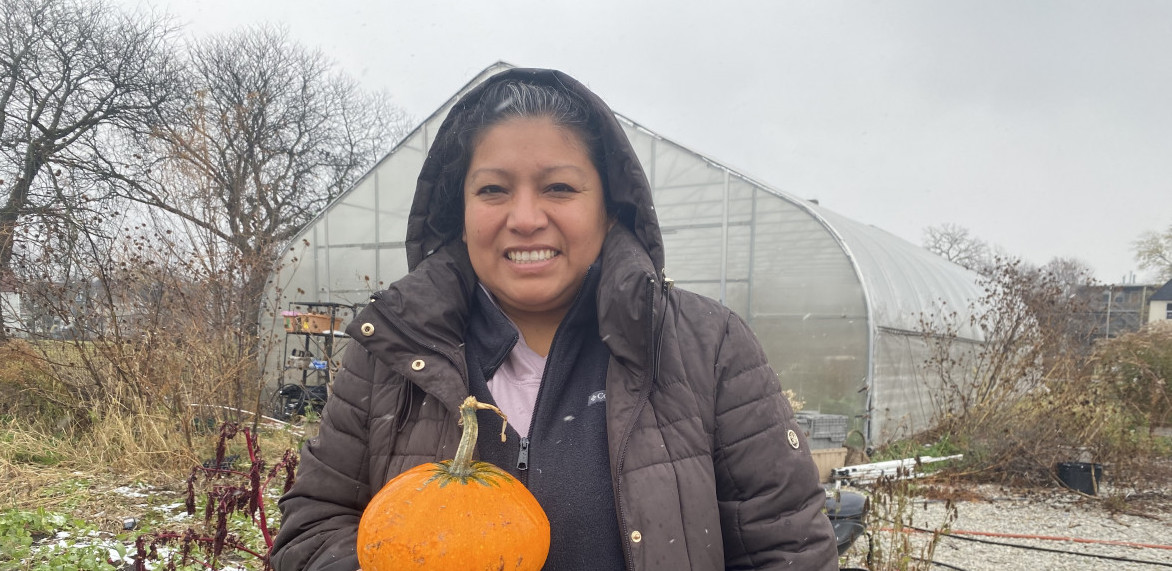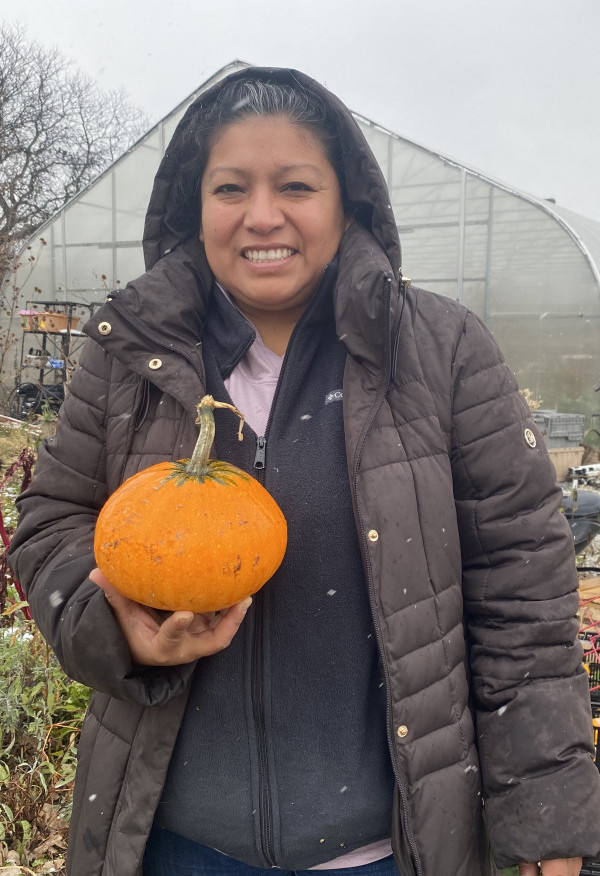
Co-founder of Cedillo’s Produce Dulce Morales standing before the farm’s hoop house. (Astry Rodriguez)

Co-founder of Cedillo’s Produce Dulce Morales standing before the farm’s hoop house. (Astry Rodriguez)
Every time Chicago resident, Andrea Freerksen digs her hands in the dirt to plant a new crop, she is warmly reminded of her late father who taught her the art of gardening at around the age of two.
Freerksen has a garden in the backyard of her South Shore neighborhood home in Chicago where she plants herbs, fruits and over 10 different vegetables. She harvests corn, green beans, bell peppers, radishes, zucchini, rhubarb and more.
“I remember being very little and [my father] making holes with his finger in the ground and being like, ‘Put a seed in each one of these holes.’ And I just thought it was cool because then it would become a plant that you can eat,” said Freerksen. “Every time I touch the earth to shape it into something pretty or edible, I definitely am connected to him.”
In the last decade, the demand for locally grown food has increased 260% in Chicago, and three-fourths of Americans report caring about having locally sourced food, according to the Chicago Metropolitan Agency for Planning.
According to The Chicago Community Trust, about one in seven people in Chicago face food insecurity.
Freerksen said she only gardens during the spring, summer and into the fall, but doesn’t have a need to continue growing after harvest season, which ends by late November.
But saving money with her garden is another bonus Freerksen said she has experienced, with the production of her tomatoes and kale alone. She said she rarely visits grocery stores for produce as she was even able to produce 14 squashes this summer from a single plant.
Locally growing produce is a strategy used by residents, urban farms and community gardens to combat food desert status in underserved neighborhoods across Chicago, especially on the South and West Sides. It also reassures people about the quality of their produce. In Freerksen’s case, she gardens for the convenience of having readily available produce untouched by harmful chemicals like pesticides.
“I also compost, and for my garden I knew I wasn’t going to use insecticides,” Freerksen said. “I use neem oil, which is not harmful. The only fertilizer I use is dead leaves, so organic compost.”
In her previous apartments, she always had a small windowsill herb garden, so when she bought her house a little over a year ago, she was excited to plant a large garden, she said.
Like Freerksen, Keith Tody, who lives in the Edgewater neighborhood on the North Side of Chicago, said he does not live in a food insecure area, but he too grows produce outside his apartment, where he has two raised plant beds in his small backyard. He has found ways to extend his growing season into the winter. He said his motivation is ensuring he is consuming fresh and healthy foods, especially as he does not often eat meat.
He usually grows spinach, different types of lettuce, kale, garlic, tomatoes and more in summer and fall.
“I decided what to plant (by) basically just Googling what’s super easy to grow,” Tody said. “When there’s big E. coli recalls on stuff like lettuce … I just try to avoid those big supply chain problems by keeping it local and independent.”
During winter, he plants winter-hardy plants like kale and carrots in raised plant beds.
In addition to concerns with the quality of produce, another big impetus for locally grown produce is food apartheid, also known as the food desert problem: Where residents only have close access to corner liquor stores, gas stations, retail locations or small grocery stores for food, but not to supermarkets with a wide selections of fresh produce.
One solution is urban farming beyond the backyard. Star Farm is a year-round urban farm operating in the South Side’s Back of the Yards neighborhood and is increasing food access in the community. It creates safe spaces for women and children to learn about sustainable foods, and has a volunteer program where people with disabilities can help package produce for sale.
Through the Community Supported Agriculture (CSA) program, a weekly (sometimes biweekly) food subscription service, they serve local residents, including senior citizens who are unable to travel for groceries. They also partner with other local organic farms to boost the local economy.
With winter underway, Star Farm is centering on growing vegetables like tomatoes, onions and zucchini to ship to the CSA members, according to communications manager and farmer Mira Cameron.
The farm has additional strategies like growing microgreens as well as broccoli, cabbage and turnips on the main site, an apartment, and in a greenhouse predominantly used in winter. During winter months, they will continue to do pop-up markets, distribute to local hospitals and sell produce at several indoor markets even outside of Back of the Yards, like in Wicker Park and Lincoln Park.
“Because we’re able to sell directly to the consumers so often, we’re able to sell them organic local produce for a relatively low price compared to what you would find at a store,” Cameron said.
Another smaller and family-run urban farm is Cedillo’s Produce in the Englewood neighborhood, which focuses on providing organic food to people of color through farmers markets in its South Side neighborhoods and those on the West Side, like Little Village. The farm operates a CSA program and provides leafy greens in the spring and fall, then fruit crops in the summer, such as tomatoes, peppers, cucumbers, eggplants and more.

Co-founder Dulce Morales said that while the farm doesn’t have a greenhouse, it has a large hoop house — an uninsulated sheltered space — and she covers some plants with low tunnels made of plastic tube arches encased by a plastic sheet, to protect crops that thrive in winter, like spinach and lettuce.
Morales said it is beneficial for people’s health to eat organically, avoiding exposure to pesticides and fertilizers.
“Knowing that your food is being harvested the day of … that it didn’t have to travel in refrigeration for a whole week before it comes to your plate, all those things are big factors for people to get the most nutrients,” Morales said.
Community gardens are another very common way of tackling food insecurity. The Urban Growers Collective (UGC) supports access to fresh foods by growing abundant produce year-round in two South Side community gardens — located in Schafer Park and Jackson Park — and eight urban farms predominantly on the South Side. The organization also provides community members with job training and workshops on growing food.
Laurell Sims, co-CEO of the organization, said it is very important to hire local residents to work in the urban farm communities and keep a consistent program going without fully relying on volunteers.
“There’s really low food access, in particularly [disinvested] black and brown communities [of] Chicago, so predominantly on the South Side, but also on the West Side,” Sims said. “When you’re really having to choose between paying rent or your heat, or our high quality produce, produce is going to be the last thing on your list.”
UGC’s produce is only available through farmers markets, their Fresh Moves Mobile Market bus, and their Collective Supported Agriculture program.
The Fresh Moves Mobile Market — which has produce and pantry items like beans and pasta — is a Chicago Transit Authority bus converted into a farmers market used to target areas with higher need of fresh groceries, to shorten the food gap in Chicago. The market is run by UGC farmers and the bus route is posted on its Instagram, which you can follow for updates. The bus has a $10 voucher for first-time shoppers, and distributed $169,000 worth of free food to people in need, Sims said.
“[Urban gardening] gives folks a place to be able to grow their own and to have food autonomy, and includes beauty in the city,” Sims said. “I think it’s really helped to foster a better living environment for the folks living in Chicago.”